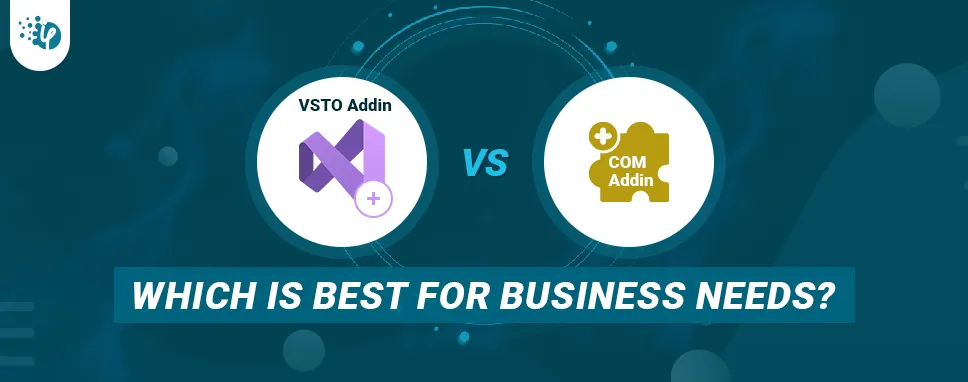How to Do Forecasting in Power BI (Steps & Accuracy Metrics)
Remember our last guide - Power BI forecasting? It revealed things that truly blocks accuracy, both structural and situational. Now it's time to take the next step. Knowing Power...
Listening is fun too.
Straighten your back and cherish with coffee - PLAY !

Tailor-made Office 365 Add-in development has become an essential aspect of modern businesses to optimize workflows and business productivity. These add-ins allow businesses to customize Microsoft Office applications like Excel, Outlook, Word, and PowerPoint to their specific requirements, unlocking new levels of efficiency and automation. However, the decision of choosing the right add-in development approach can be challenging, as businesses have two primary options: VSTO (Visual Studio Tools for Office) Add-ins and COM (Component Object Model) Add-ins.
In this comprehensive blog, we will explore the key features, benefits, and drawbacks of both VSTO and COM Add-ins to help you make an informed decision for your business needs. By understanding the capabilities of each option, you can select the most suitable approach to maximize the value and impact of your customized Microsoft Office applications.
VSTO Addins are extensions for Microsoft Office applications that are created using the .NET framework and Visual Studio. They leverage the power of the .NET platform, providing a wide range of programming languages and tools to develop customized Office solutions.
VSTO Addins offers seamless integration with Office applications and provide a higher level of interaction and customization compared to COM Addins.
COM Add ins, on the other hand, are built using COM technology, which enables software components to interact with each other within the Windows operating system. COM Add-ins are developed using traditional programming languages such as C++ or Visual Basic, and they have been around for a longer time compared to VSTO Add ins.
They provide a lower level of integration with Office applications and are typically used for simpler customization scenarios.
When deciding between VSTO Add-ins and COM Add-ins for your business needs, it is important to consider a few factors:
VSTO Add-ins provide a more modern and comprehensive framework for customization. If your business requires complex interactions with Office applications, such as creating custom task panes, manipulating the Office document object model, or integrating with external APIs, VSTO Plug-ins are the recommended choice. They offer a higher level of control and flexibility, allowing you to create sophisticated solutions tailored to your specific requirements.
COM Add-ins, on the other hand, are suitable for simpler customization scenarios. If you only need to add a few buttons or menus to Office applications or perform basic automation tasks, COM Add-ins may be sufficient for your needs. They are easier to develop and require less technical expertise compared to VSTO Add-ins.
The choice between VSTO Addins and COM Add-ins also depends on the development experience and skillset of your team. VSTO Addins require knowledge of the .NET framework and programming languages such as C# or VB.NET. If your development team is already familiar with custom .NET development or if you have .NET expertise in your organization, VSTO Addins can be a natural choice.
COM Addins, on the other hand, are based on COM technology and typically require knowledge of languages like C++ or Visual Basic. If your team has experience with COM development or if you have existing COM-based solutions, COM Addins may be a preferred choice to build upon your existing expertise.
Consider how you will deploy and distribute your customized Office solutions. VSTO extensions are deployed as managed code assemblies and can be easily distributed using ClickOnce technology, which simplifies installation and updates. VSTO add-ins also have better compatibility with different versions of Office applications, ensuring that your add-ins work across different Office environments.
COM extensions, on the other hand, require more manual deployment and registration steps. They are also more prone to compatibility issues when used with different versions of Office applications. If you require seamless deployment and compatibility across various Office versions, VSTO Add-ins offer a more convenient solution.
Choose VSTO Add-ins over COM Add-ins for modern development, smooth integration with Office, and enhanced security. VSTO supports the latest Office versions, enables user-friendly updates, and offers managed code for better performance. It's a future-proof choice for creating a secure, efficient, and user-friendly Office customization environment.
To add more, VSTO plug-ins provide enhanced security features, lowering the risk of malicious code execution. This is crucial in today's cybersecurity landscape where sensitive data must be protected at all costs.
1. Easy Development: VSTO Add-ins include a full set of tools and documentation, making the development process simple and accessible. The usage of Visual Studio as the development environment allows developers to create code more effectively and considerably shortens the learning curve.
2. Easy Debugging: Debugging is an essential part of the development process, and VSTO Add-ins provide powerful debugging capabilities to help with troubleshooting and issue resolution. The Visual Studio debugger delivers real-time information, helping developers quickly detect and repair errors.
3. Integration with Microsoft Office: VSTO Add-ins seamlessly integrate with Microsoft Office applications, granting developers access to the powerful object model of these applications. This interface enables the development of feature-rich add-ins that interact with Office documents and automate numerous processes.
4. Wide Range of Functionality: VSTO Add-ins offer a full range of built-in capabilities, such as custom task windows, custom ribbons, and custom actions. This built-in feature helps developers to focus on creating business logic, saving important development time.
1. Dependency on .NET Framework: A significant drawback of VSTO Add-ins is their reliance on the .NET Framework. This means that the .NET Framework must be installed on client machines to run the add-ins, potentially leading to additional deployment complexities.
2. Compatibility issues with other platforms: Because VSTO Add-ins are primarily built for Windows systems, cross-platform compatibility may be limited. If your company wants add-ins that can operate on platforms other than Windows, VSTO may not be the ideal option.
COM Add-ins, based on the Component Object Model, offer a versatile approach to developing add-ins for Microsoft Office applications. These add-ins are compatible with both Microsoft and non-Microsoft operating systems, making them an attractive choice for businesses with diverse user environments.
1. Cross-Platform Compatibility: One of the most significant advantages of COM Add-ins is their ability to run seamlessly on both Microsoft and non-Microsoft operating systems. This cross-platform compatibility extends the reach of the add-ins and ensures they can be used across diverse user environments.
2. Long-Term Stability: COM technology has been a well-established part of the Microsoft Office ecosystem for a considerable time. Implementing COM Add-ins ensures stability and reliability, even as the Office applications continue to evolve.
3. Wide Support for Programming Languages: COM Add-ins provide developers with the flexibility to use various programming languages, such as C++, to create customized solutions. This broad language support allows businesses to leverage their existing expertise effectively.
1. Complex Development Process: ODeveloping COM Add-ins requires in-depth knowledge of COM technology, making it a challenging option for novice developers. The native Windows API used in COM development can be complex, leading to longer development times.
2. Complex Debugging Process: Debugging COM Add-ins presents unique challenges as the debugger cannot directly attach to Office applications. Special tools and techniques must be employed to effectively debug COM Add-ins, which may require additional expertise.
Choosing Between VSTO Add-ins and COM Add-ins depends on a thorough analysis of your business needs and specific requirements. Both VSTO and COM Add-ins offer unique advantages and can cater to different use cases.
Understanding the specific functionality your add-in needs to provide is a key factor in choosing the right solution. VSTO Add-ins are an excellent choice for projects requiring rapid development, advanced debugging capabilities, and a wide range of built-in features. On the other hand, COM Add-ins are ideal for businesses seeking cross-platform compatibility and long-term stability.
Consider the target deployment environment for your add-ins. VSTO Add-ins are well-suited for businesses primarily deploying on Windows platforms. In contrast, COM Add-ins offer the advantage of running on both Microsoft and non-Microsoft operating systems, making them suitable for businesses with diverse user environments.
The size and complexity of your project can influence the choice between VSTO and COM Add-ins in terms of performance. VSTO Add-ins are generally better suited for smaller projects with a focus on speed and efficiency. In contrast, COM Add-ins offer high performance and reliability, making them an excellent choice for larger and more complex applications
Consider the skillset of your development team when choosing between VSTO and COM Add-ins. If your team is well-versed in .NET technologies, VSTO Add-ins provide a familiar and straightforward development process. Conversely, if your team has experience with other programming languages like C++, opting for COM Add-ins can be a viable choice.
Both VSTO Addins and COM Addins have their strengths and limitations. VSTO Addins provide a more modern and robust framework with extensive customization capabilities, making them well-suited for complex scenarios. COM Addins, on the other hand, are easier to create and are appropriate for minimal customization needs.
Consider the complexity of your customization requirements, your development team's skillset, and the deployment and compatibility needs of your Office solutions. By carefully evaluating these factors, you can choose between VSTO Addins and COM Addins to find the best fit for your business needs.
Remember that using the right technology will allow you to efficiently customize and improve Microsoft Office programs to optimize your internal operations and maximize productivity.

Remember our last guide - Power BI forecasting? It revealed things that truly blocks accuracy, both structural and situational. Now it's time to take the next step. Knowing Power...

Security has always been a major concern. Your company spends millions on cybersecurity tools, and guess what? You’re still vulnerable. When you're working in the cloud, especially...

Automation isn’t just a trend anymore. It’s a must-have for any business relying on the Cloud. As the firm grows, cloud infrastructure gets more complex. So, choosing the right Infrastructure...